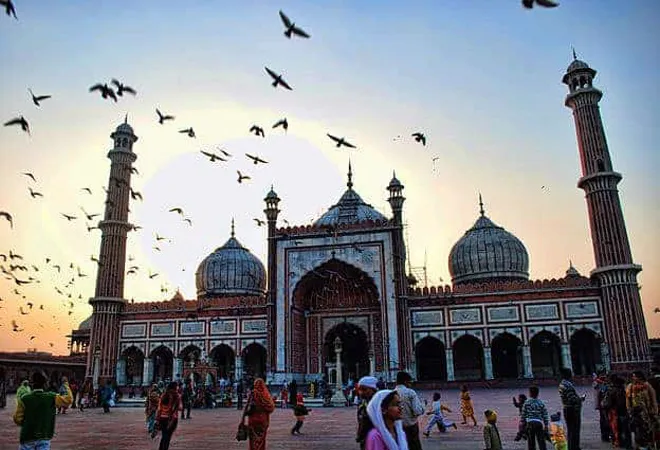
Most observers studying Salafism are often confused about the nature of the group and tend to conflate Salafists in any part of the world with Wahhabis and terrorist groups like the Islamic State and al-Qaeda which espouse a militant version of Salafism. This article sheds light on political Salafism in parts of South Asia in a bid to understand the movement better.
History of the Ahl-i Hadith in the Indian Subcontinent
The primary Salafist movement that is prevalent in most parts of India, Pakistan, and Bangladesh is the Ahl-I Hadith (people of the Hadeeth). The Ahl-i Hadith was formed through the religious contributions of the 18
th century ideologue
Shah Waliullah Dehlavi, a Sufi scholar who studied in Saudi Arabia and was among the first to bring the traditions of studying Hadith (sayings of the prophet) from Mecca and Medina. His thought process which was mainly focused on reforming religious beliefs was taken forward by other scholars such as Shah Abdul Azeez as well as others such as
Syed Siddiq Hassan Khan of Bhopal (d. 1832) and
Nazeer Hussain Dehlawi (1902).
In the Revolt of 1857, many Muslim figures who were involved or later arrested and hung were allegedly a part of the Ahl-i Hadith movement giving birth to the term the ‘Wahhabi Trials’.
While the group was largely focused on religious reform, many of its members were also involved in politics during the British Raj. Accordingly, in the Revolt of 1857, many Muslim figures who were involved or later arrested and hung were allegedly a part of the Ahl-i Hadith movement giving birth to the term the ‘
Wahhabi Trials’.
Importantly, while the movement did not gain many followers across British-ruled India, many of its above-mentioned scholars and leaders were members of influential families across the nation and thus, they were able to sustain the movement. By
1906, an all-India Ahl-I Hadith conference was organised whereby the movement was formalised as the Jamaat Ahl e-Hadeeth (JAH). During the Partition, a faction of the movement decided to
shift to Pakistan. The movement then further split in 1971 after the formation of Bangladesh. Thus, the Ahl-i Hadith movement split into three different branches with completely different trajectories.
Salafism in Bangladesh and Pakistan: The presence of political and violent strands.
The JAH in all three nations has had a colourful past. The Pakistani JAH was roped into the political scenario of the nation with the formation of the Markaz Jamiat Ahl e-Hadith (MJAH) in
1986 as a political party with control of all Ahl-i Hadith madrassas in the nation as well as youth party too. The
primary goal of the party was to reject western influences and to establish a political system based on Islamic law. The party, however, did not achieve much political mileage save an
election in 2002 where it gained about 11 percent of the total vote in conjunction with many other Islamist political parties and the backing of the military. Post this election, the group remained a largely insignificant political force in the nation.
By 1989, the MJAH also formed a militant wing termed the
Tehrik-e Mujadhidin which fought against Indian security forces in Kashmir, with the backing of the Pakistani military and intelligence. This was part of the Pakistani deep state’s broader efforts to disturb peace in India, especially in the Kashmir region. Moreover, many members of the Ahl-i Hadith
also joined the Lashkar e-Taiba (responsible for attacks across India) as well as its charity face, the Jamaat ud Dawa.
After the formation of Bangladesh, the movement was generally aloof from politics till the advent of an Arabic professor at the Rajshahi University of Bangladesh called
Asadullah Ghalib. Ghalib first formed the
Ahle Hadith Jubo Shangha (AHJS) in 1978 which later transformed into the
Ahl e-Hadith Andalon Bangladesh (AHAB) in 1994 with the aim of transforming Bangladesh into an Islamic State. The AHAB soon made massive inroads by creating networks of Madrassas and NGO’s that garnered significant support in the nation with some figures claiming about 25 million members, sympathisers, and followers collectively. By 2006, the group
declared its intentions to contest about 60 different seats in the upcoming elections although these plans were thwarted after a military coup after which the group became largely irrelevant as a political force.
By 2006, the group declared its intentions to contest about 60 different seats in the upcoming elections although these plans were thwarted after a military coup after which the group became largely irrelevant as a political force.
In terms of violence, the group was considered as the ideological fountainhead of the Jamaat ul Mujahideen Bangladesh (JMB) which was responsible for several bombings and terrorist attacks across Bangladesh with a few incursions into India too. The leader of AHAB, Ghalib was even
arrested in 2005 for terrorism charges although he was let go in a few years for lack of evidence. Nonetheless, both Bangladesh and Pakistan have demonstrated that the Salafists of these nations have had a deep seated presence and have engaged both in politics as well as terrorist activities too.
India
In India, the very same Ahl-i Hadith that stayed back, maintained a low political profile, preferring instead to engage with the purification of the religion and debating other Muslims (especially Sufis) on practises of going to shrines. While the Bangladeshi and Pakistani chapters too focused on this, the
Indian chapter did not enter the realm of politics apart from voting. According to leaders within the movement, they often encouraged their followers to vote for the sake of the Muslim community. The JAH in India has largely been silent on many political issues and its leaders have even spoken
in favour of decisions made by the current government such as in the splitting of Jammu and Kashmir into two different parts.
In parts of South India, a different movement called the
Kerala Nadwatul Mujahideen (KNM) was formed (1950) with ideological influences from Egypt in the 1920’s. The group has engaged more than the JAH in politics by linking up with the Indian Union Muslim League (IUML) and in some cases, even the left front of Kerala. The leaders often consider it a
duty to vote and demonstrate patriotism to the nation. Both the JAH and KNM are
critical of violent and terrorist groups launching several campaigns to combat radicalisation and extremism and both have not faced any major allegations of connections to any terrorist groups.
The group has engaged more than the JAH in politics by linking up with the Indian Union Muslim League (IUML) and in some cases, even the left front of Kerala.
Table 1: A comparative look at Salafist organizations in India, Pakistan and Bangladesh. Other nations in South Asia not covered.
| Country |
Group Name |
Established |
Politics |
Violence |
| India (North) |
Markaz Jamaat Ahl e-Hadeeth |
1906 |
Largely Aloof |
Strictly opposed |
| India (South) |
Kerala Nadwatul Mujahideen |
1950 |
Indirect (pressure group for the IUML) |
Strictly opposed |
| Pakistan |
Markaz Jamaat Ahl e-Hadeeth |
1986 |
Contests Elections |
Some factions open to violence. MJAH has a militant wing and has contributed recruits to Lashkar e-Taiba |
| Bangladesh |
Ahl e-Hadeeth Andolan Bangladesh |
1994 |
Contests Elections |
Some factions open to violence. Contributed to Jamaat ul Mujahideen Bangladesh ideologically and via recruits. |
Acknowledging diversity among South Asian Salafists
The four groups covered above barely scratch the full spectrum of Salafists in South Asia with different groups in Maldives, Sri Lanka, and Afghanistan. Yet, a few things become clear when looking at the figure above; Firstly, Salafist politics varies in different nations based on the broader political context of the nation. Second, due to the majority Muslim dynamics in Pakistan and Bangladesh, Salafist groups have been quite comfortable contesting elections as political parties whereas the connection was not as clear cut in India. Third, political ambitions have also caused the militarisation of some (not all) Pakistani and Bangladeshi Ahl-iHadith factions although, not much sustained evidence has surfaced regarding Indian Salafist connections to violence and terrorism. Fourth, even though Saudi funding was responsible for enriching the respective movement since the 80’s, the Salafists of South Asia have existed long before Saudi support in South Asia. Thus, it is important for policymakers across the world to look critically at the different Salafist movements across South Asia separately to effectively engage with the movement in each country.
The views expressed above belong to the author(s). ORF research and analyses now available on Telegram! Click here to access our curated content — blogs, longforms and interviews.



 Most observers studying Salafism are often confused about the nature of the group and tend to conflate Salafists in any part of the world with Wahhabis and terrorist groups like the Islamic State and al-Qaeda which espouse a militant version of Salafism. This article sheds light on political Salafism in parts of South Asia in a bid to understand the movement better.
Most observers studying Salafism are often confused about the nature of the group and tend to conflate Salafists in any part of the world with Wahhabis and terrorist groups like the Islamic State and al-Qaeda which espouse a militant version of Salafism. This article sheds light on political Salafism in parts of South Asia in a bid to understand the movement better.
 PREV
PREV


